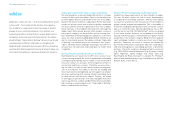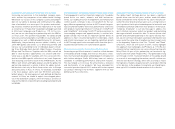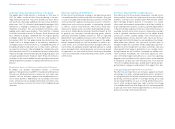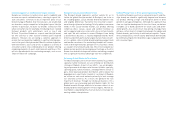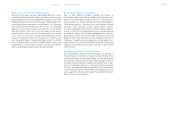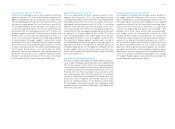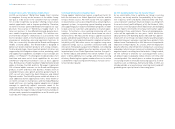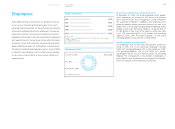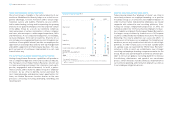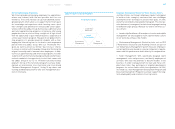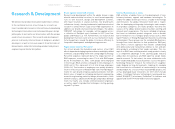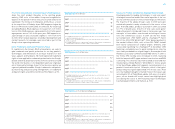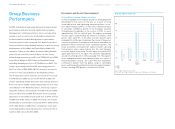Reebok 2006 Annual Report Download - page 66
Download and view the complete annual report
Please find page 66 of the 2006 Reebok annual report below. You can navigate through the pages in the report by either clicking on the pages listed below, or by using the keyword search tool below to find specific information within the annual report.› Structure and StrategyGroup Management Report ›
062 ANNUAL REPORT 2006 › adidas Group ›
Strong Progress with “World Class Supply Chain”
In 2005, we started our “World Class Supply Chain” initiative
to reengineer the way we do business at the adidas Group.
Our goal is to be closer to the consumer than our competi-
tors in order to optimize our product offering, to best attack
market opportunities and to improve profitability. Therefore,
we want to increase speed and flexibility throughout our sup-
ply chain. The essence of “World Class Supply Chain” is to
move our business to five differentiated and dynamic busi-
ness models targeting consumer needs. This initiative cov-
ers the whole concept-to-shelf process (i.e. all activities from
the first product sketch to the final delivery to retailers) and
encompasses marketing, sales and operations functions. In
2006, we successfully introduced the Brand and Evergreen
models at brand adidas. The Brand model is designed to
deliver our brand statement products with strong concepts.
To drive brand image, these important product initiatives are
supported by full-fledged customer service, marketing, retail
and supply chain capabilities. Examples of such concepts are
adidas_1 or Predator®. The Evergreen model provides short
lead time and never-out-of-stock capabilities for our most
commercial long-lifecycle products such as basic apparel
lines. Both business models have been implemented at brand
adidas in Europe, the USA and Asia. We expect to generate
20% of brand adidas revenues via the Brand and Evergreen
products in 2007 and these new business models show an
overproportionate sales growth potential going forward. In
2007, we will also launch the Quick Response and Global/
Regional models. The Quick Response model will allow us to
seize additional market opportunities with a three-month or
six-month concept-to-shelf process and the Global/Regional
model will focus on creating regional adaptations of global
concepts to specifically address consumer needs in the
respective market. We expect to implement a fifth model by
2008 and have the target to reduce the portion of our products
that we create, manufacture and deliver on an 18-month cycle
to 25% by 2010 (today around 75%).
Continued Optimization of Supplier Base
Strong supplier relationships remain a significant factor for
both the outcome of our Global Operations activities and the
Group’s overall success. We work closely with our suppliers
on key initiatives such as boosting efficiency, enhancing man-
agement systems, incorporating special handling programs
and supporting quick response fulfillment programs in order
to best serve our customers and capitalize on market oppor-
tunities. To facilitate a close working relationship with our
suppliers, we have cross-functional teams based on-site at
many factories. We measure the Group’s suppliers based on
quality and delivery performance criteria but also regularly
monitor their social and environmental compliance (see Sus-
tainability, p. 63). We further assess our suppliers using more
subjective ratings such as customer satisfaction levels and
innovation. Following the acquisition of Reebok, consolidating
and optimizing our supplier base has become an even more
important part of our Global Operations function. Our goal is
to further reduce and optimize the overall number of sup-
pliers to drive additional cost savings and increase sourcing
efficiency. Reducing the supplier number allows us to realize
scale benefits in purchasing and will help us increase consis-
tency in product quality.
EU Anti-Dumping Duties Have No Material Impact
As we consistently strive to optimize our Group’s sourcing
structure, we closely monitor the probability of the imposi-
tion of quotas, tariffs and duties and proactively take mea-
sures to prevent significant financial impacts resulting from
those restrictions (see Risk Report, p. 96). On October 5, 2006,
the Council of the European Union imposed an anti-dumping
duty on imports into the EU of footwear with leather uppers
originating in China and Vietnam. These anti-dumping mea-
sures will be applicable for two years. Initial discussions
about potential anti-dumping duties indicated that approxi-
mately 20% of our Group’s footwear volume would have been
impacted. However, we began sourcing these products from
Indonesia and Thailand early in 2006 because of the potential
imposition of import duties. As a result, when the legislation
became effective, only limited fine-tuning of our source base
and product allocation was necessary to eliminate virtually all
negative impacts resulting from these duties. Going forward,
we will continue to diversify our sourcing portfolio across
all product types to gradually reduce reliance on China-only
sourced product. Our overall plan is to reduce the proportion
of sourcing volume in China by increasing capacities in other
countries such as Indonesia, Vietnam and India. In 2006, we
introduced India as a new footwear sourcing country and will
gradually grow capacity there in the coming years.


